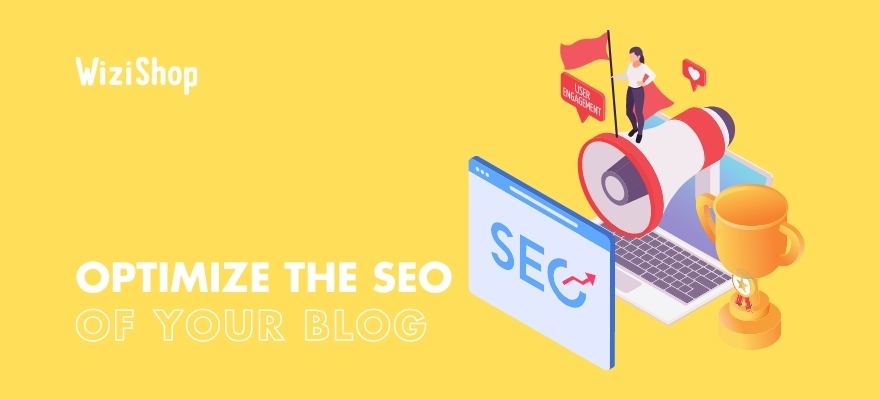Many merchants take to blogging regularly to try and gain more traffic and position themselves on new keywords related to their topic.
And they’re right to do so!
The blog can become a very interesting growth lever for your business...but you still have to use it wisely.
In the majority of cases, e-merchants who don’t get results from their blog aren’t following SEO best practices. This in turn leads to content that never ranks and is therefore a waste of time.
To optimize your investment when writing articles for your online store, it’s therefore important to follow a few guidelines. By applying these different tips, you’ll dramatically increase your blog traffic, generate more revenue, and save time!
Why create a blog to improve your SEO on Google?
Improve your notoriety and visibility
First, a blog, when properly optimized, can seriously improve your brand’s visibility on the internet.
When internet users search for information related to your theme on search engines like Google and you respond to those queries through your editorial content,
they’ll come across your site and your brand much more frequently.
In addition, the articles you publish are great information to relay across all of your social networks. This also allows you to get noticed and to be displayed more regularly to your community.
Position yourself as an expert
Not only does it improve your visibility on search engines, a blog also creates a great image for your business.
By sharing qualitative content with your visitors, you position yourself as an expert in your field, truly passionate about your industry.
Remember: the goal of the blog is not to post content just as a matter of principle. It’s above all an added value for the SEO of your ecommerce site. This is particularly crucial since search engines, especially Google, don’t really appreciate low-quality content that doesn’t generate any traffic.
It’s therefore recommended to publish quality content that’s interesting for your audience, even if it means publishing less frequently.
Provide quality information to your customers
As you’ll have understood, the blog doesn’t only have an SEO goal. It must also provide additional and qualitative information to your customers.
It’s, in a way, a way to showcase your field of activity and your knowledge.
Furthermore, it’s also a channel that humanizes the relationship you have with internet users. It’s an additional vector of confidence and therefore an excellent sales lever.
Take advantage of your blog to show your know-how and your expertise! The creation of relevant content with high added value is one of the main elements in any self-respecting SEO strategy.
Increase the number of keywords positioned for your site
One of the keys to correctly ranking your blog on Google is to respond to the search intent of internet users. Thus, the words you aim to use shouldn’t be chosen at random. This is one of the things I’ll explain to you later in the article.
By creating posts on well-targeted topics, you’ll rank on many keywords related to your field of activity, improve your SEO, and attract more visitors to your pages.
By adopting a good frequency of publication, it’s also a great way to develop your brand and differentiate yourself from the competition.
Get natural backlinks
Having a blog with high-quality content often naturally leads to backlinks.
Logically, the more interesting your posts, the more they’ll be cited by other sites. This strategy for link building is also called link baiting.
You’ll thus obtain many backlinks, attracting more and more visitors to your site and increasing the confidence in your online store by search engines like Google.
To maximize the chances of acquiring backlinks to your domain name and your content, also consider diversifying your formats: infographic, case study, videos, guide, etc.
What optimizations will boost your blog’s SEO traffic on Google?
To put the odds in your favor and improve the SEO of your blog on Google, certain elements must be carefully considered. Here’s a list of the main levers!
Analyze the audience
The first step to take when writing a blog post is to put yourself in the shoes of your visitors:
- Who are you writing this content for?
- What are the expectations and needs of your visitors?
- What are the issues?
- What information is the user looking for?
- What type of content is expected by the user?
These questions allow you to define your persona, their needs, and the message you want to convey.
Your audience should ideally include your target audience, meaning your existing customers and your potential customers. The objective of the blog is to attract a maximum of qualified visitors to generate more business.
If you don’t have a website yet, think about making a business plan before launching your new venture. This plan must integrate the notion of prospect and target.
On the other hand, if you already have an online store, explore the demographics of your visitors, analyze readers’ interests, determine the social networks where they browse the most...really get to know your audience!
Perform keyword research
The other preparatory element when writing a new post is the choice of keywords. Here again, put yourself in the shoes of your potential customers and ask yourself what searches they’re likely to perform on the internet.
What are the informative queries that can potentially attract a maximum of qualified traffic to your pages? These are the keywords you should aim to use in your blog!
I specify “informative,” because on a blog, you’ll often address various issues related to your theme to meet the needs of internet users.
The search intention is not the same on a blog post as on a product page or a category page.
For example: “how to repair a dishwasher,” “which backpack to choose for winter hiking,” “how to clean a surfboard,”...
The blog is a perfect medium to target all these long-tail informational queries. You’ll bring clear and precise answers to internet users while highlighting your products.
The choice of keywords must be an integral part of your writing strategy.
Optimize the post’s SEO elements
Once you’re aware of the keyword that internet users are looking for and the type of post to be written, you should position yourself as an expert in your field, by providing them with quality content.
However, it’s still necessary that it’s optimized at the SEO level to rank on Google and obtain visits in the long term! All the elements of your blog pages must be optimized.
Nothing should be left to chance, whether it’s your images, your texts, your titles, or your URLs.
- Title tag
The title tag is a very important element, since it’s the title that’s displayed first in the search engine results. It also has significant weight in the Google algorithm.

It’s one of the first things that internet users will see. You must therefore optimize it with your main keyword but also use it to make users want to click and access the rest of your text. To be effective, the title tag must be clear, concise, and punchy.
Full article on the title tag: https://wizishop.com/blog/title-tag
- Meta description tag
The meta description tag, on the other hand, is the element just below the title tag. This is a very concise summary of the content that can be found on your page.
This item isn’t directly considered for Google positioning. However, this text will also have a strong impact on the click-through rate…it should spark the curiosity of internet users and should encourage them to visit your post.
Full article on the meta description tag: https://wizishop.com/blog/meta-description
- URL
The URL is the internet address of your pages. The best practice is to keep your URL short and simple.
For example, say that you write a post on “Which backpack should you choose for a winter hike?” A seo-friendly URL would be “winter-hiking-backpack.”
Full article on URLs: https://wizishop.com/blog/url-structure-seo
- H1 tag
The H1 tag is the title displayed on the page of your article. Sites generally use the same content for the title tag and the H1 tag, but if you can, I advise you to diversify them a bit, while keeping the main keyword.
The H1 title must be unique and attractive.
Each of your blog posts must have its own title. If you end up with two articles with the same title, it’s very possible that you haven’t analyzed the target keyword properly. Each page should aim to include a different group of keywords.
Full article on the H1 tag: https://wizishop.com/blog/h1-tag
- Hn structure
The Hn structure designates the different titles present in your posts. These must be structured according to different levels (from 1 to 6), depending on the importance of the titles and subtitles.
The Hn tags, also known as heading tags, are the elements that allow you to better structure your articles. They are important for referencing and for the reader. These tags allow you to better structure your ideas and improve the readability of your content.
Ideally, you should also include keywords in your titles.
Full article on heading tags: https://wizishop.com/blog/heading-tags-seo
- Keyword density
Your keyword must be well chosen and must be present several times in your text, without detracting from the reading. Your keyword must appear frequently but naturally in order to avoid over- optimization, which can have a negative impact on SEO.
- Lexical field
The lexical field used in your blog texts is also a central element to position yourself effectively in SEO.
In addition to the main keyword, the lexical field related to the semantic universe of your text is very important. Therefore, think about defining a whole list of synonyms or related keywords to integrate in your articles.
You can first take a step back from your theme. For example, if your post is about choosing winter hiking bags and you’re sharing tips, you might include the following words: winter, temperature, snow, protection, cold, weather, equipment, etc.
Then, you can also use free and paid tools on the internet for your SEO writing: Google Suggest, YourTextGuru, etc.
- Alt attribute
The Alt attribute (or alternative text) is used to describe an image. It's an important element for your SEO. You must therefore specify a description for each of the visuals you add in your blog posts.
By the way, note that if a technical problem on your website prevents your images from being displayed correctly, this text will appear in their place, which can be useful for internet users.
Full article on the Alt attribute: https://wizishop.com/blog/alt-text
- Internal linking
In your blog, also think about setting up internal links between your different articles and pages to create a relevant internal linkage.
This system allows your visitors to navigate from one content to another in a logical way and to pass some SEO juice between your different URLs.
For example, if you have articles that are complementary to the topic that you’re currently covering, it might be beneficial to add internal links to this content. In the same case, if you have relevant categories or products to highlight in the post or even your homepage, don’t hesitate!
When creating internal links, optimize your anchors as much as possible and use your internal mesh to give juice to the most important pages of your site, such as the categories.
You now have everything you need to optimize your blog posts as much as possible and rank well on Google. Working on the SEO of your content is a time-consuming task, but rather than spending it writing irrelevant texts that never rank, you can finally make the most of your time!










